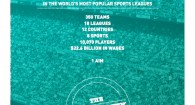- 0
By Nick Harris
16 September 2010
One of the noisiest, brightest, most exuberant scenes in European football, if not the world of sport, symbolises why Steve McClaren is still enjoying the Bundesliga despite the pressure he’s experiencing at Wolfsburg from three defeats in his first three games.
The former England manager witnessed this scene in person on Saturday, as Wolfsburg lost 2-0 at Borussia Dortmund. “Magnificent,” he called it, and it’s certainly extraordinary.
It’s Dortmund’s ‘Yellow Wall’, or Gelbe Wand, aka the precipitous Südtribüne terrace at the club’s Westfalenstadion, a ground that holds 81,000 fans for league games, and just shy of 66,000 for internationals (seats only).
The Wall alone houses 25,000 people for domestic fixtures, and of the places available in this bouncing, barmy swarm – a sea of flag-waving yellow, from the shirts of Dortmund – 24,000 are sold as season tickets, the others much sought after on a match-by-match basis.
The cost? A season ticket for £150, and individual games for £9 to £11. You can drink beer, eat sausage, be raucous, watch the footy and then, at the final whistle, take part in a ritual that helps to bind the team and the fans. The players line up to applaud in homage to the Wall. The Wall en masse gives the ‘We’re not worthy bow’ with flailing arms.
As with the biggest European nights at Anfield or Celtic Park – venues where games are also prefaced, as at Dortmund, by a rendition of ‘You’ll Never Walk Alone’ – witnessing it can send a tingle down the spine.
McClaren could be forgiven at the weekend for not dwelling long on this. He had, after all, just recorded his hat-trick of losses, with the pressure mounting ahead of his fourth game, this weekend’s hosting of Hannover. Yet he remained enthused enough by his new surroundings to describe how the German love for the beautiful game is every bit as passionate as in England.
“Every stadium you go, the atmosphere is fantastic,” he said. “The Germans love their football and they love being successful and their league is growing [in popularity].
“My first impressions are that it’s a very tough league, very competitive every week, a little like the Premier League. To win in the Bundesliga today, just like winning in the Premier League, takes so much effort, so much focus, so much concentration. When you win in any week, it feels like a cup final, and that’s how it is here. It’s like the Premier League in that any team can win on a given day.”
Wolfsburg lost his first match 2-1 in a last-minute defeat at Bayern Munich, then lost 4-3 after being 3-0 up (to Mainz), then lost on Saturday. But he says: “The beauty of the German Bundesliga is any one of 10 teams can win [the title]. They’re not so far apart . . . so it’s very open.”
This is glowing testimony, and it isn’t isolated. A common perception is the Bundesliga is a league, in all senses, of harmony; one with strict rules that dictate club members should own 50 per cent plus one share of voting rights – the “50 per cent +1” regulation; that there are few debt issues, sensible wages and cheap tickets; and that a vibrant youth system with an emphasis on home talent helps feed a vibrant German national team.
All this is true, broadly, although all leagues have flaws and drawbacks, and it’s no different in Germany. Not all clubs operate under “50+1” ownership; majority holdings are allowed in some circumstances after long affiliations. McClaren’s club Wolfsburg are owned 100 per cent by Volkswagen, for example, and Bayer Leverkusen are owned 100 per cent by the pharmaceutical firm Bayer. These industrial giants pick up the tab for losses at their clubs, which are owned for marketing as well as community reasons. Their subsidies are not Abramovich-esque, but not always popular with rivals.
At Hoffenheim, the major shareholder is Dietmar Hopp, a software billionaire ranked inside the world’s 700 richest people in 2006, and while he isn’t technically in majority control he’s poured in tens of millions to take his club from the eighth division to the elite in 10 years and has an effective carte blanche to do what he likes.
At Hannover, meanwhile, president Martin Kind is challenging the “50+1” rule because he wants to be majority owner, and invest more money to try to build his club to compete in Europe. Having a relatively equal league is fine, but Germany has not had a Champions League winner since Bayern in 2001.
Minority control discourages such investment, Kind argues. A legal verdict on his challenge to “50+1” could arrive as early as next month and change German football.
While the Bundesliga has never seen a club go bust or enter administration (unlike the Premier League, with the blot of Portsmouth, from which painful lessons should be learned), it would be wrong to say financial problems never occur in German football.
There are no individual debt mountains akin to those amassed as a result of the leveraged buyouts at Manchester United and Liverpool. But Schalke’s debt reached £210m last year. Dortmund came close to bankruptcy in 2005 and did a stadium rights naming deal (2006-11) with insurance firm Signal Iduna to keep the wolf from the door. And 1860 Munich, home-sharers with Bayern Munich and in the top division as recently as 2004, are a financial basket case, forced to sell their share in the Allianz Arena in 2006 to avoid going bust and now surviving partly through the largesse of Bayern.
Having said all that, Bundesliga clubs do, typically, make regular profits. They are largely unsusceptible to the whims of trophy-asset owners. They keep prices low, with average tickets at £18.30, about half Premier League levels.
Selected tickets are as cheap as £6 at Bayern Munich. Many clubs include free local travel in the price. Ordinary fans are subsidised by some of the most expensive luxurious corporate seats in the world: £25,000 per season at the top end at Bayern. Average Bundelsiga attendances are the highest in world football, at 42,000 per match against 34,000 in the Premier League.
At development level, German football is healthy, witnessed not just in the youthful success of Germany finishing third at the South Africa World Cup. A tour of Dortmund’s academy on Saturday was hosted by Lars Ricken, who famously scored for Dortmund against Manchester United at Old Trafford in the 1997 Champions League semi-final, then became the youngest winning scorer in an ECL final, against Juventus, netting with his first touch.
A charming, articulate, one-club-for-life man, at 34 he now works at the academy and explains the ethos that has persuaded Bundesliga clubs to invest £430m collectively in youth development since 2002. All Germany’s elite academies must have specific standards of pitches, equipment and coaches. Quotas for German youngsters at U16 to U19 level have helped increase the number of Germans academy products in the league – and the national team.
Even the developmental tactics (4-2-3-1) and “philosophy and concept of playing” are matters of written policy at Dortmund, a good example of a high-achieving system. “Those [tactics] are most popular in the Bundesliga,” Ricken says. “And we believe this system gives you the possibility of playing all the other systems, and offers all the variations . . . The national team essentially plays the system, aggressive, well schooled, well trained.”
Has the summer’s World Cup performance given the game a boost? “Football in the Ruhr always been popular, it’s never reduced,” he says. “We didn’t need a good World Cup to boost football.”
Football has a place within the wider national mentality in Germany that it doesn’t in England. Most Premier League clubs have good academies (18 of them, while Wigan and Blackpool have Centres of Excellence) doing much the same as in the Bundesliga. And most “scholars” in England are English (82 per cent aged 16-18), as most are in Germany.
But at a wider level, Germany society – especially the education system – demonstrably treats sport as much more important. Education is more flexible in Germany, where a Bundesliga “scholar” will reach 18 having had 10,000 hours “contact time” at his club, against 3,000 hours in England.
If Steve McClaren should get a result against Hannover this weekend, and go on from there to extend his stay in Germany, he’ll no doubt discover this and other pluses. He’s already seen enough to want that to happen.
“The stadiums are great, magnificent; the atmosphere is brilliant,” he says. “So despite the results – and I knew it was going to be hard at the beginning – I’m enjoying it.”
.
Relative strengths: the Bundesliga v the Premier League in numbers
Average attendance (more context): Bundesliga 42,000, Premier League 34,000
Global popularity (annual income from overseas TV rights): Bundesliga £35m, Premier League £479m
Average ticket prices: Bundesliga £18.30 per seat, Premier League c.£36 per seat (but variations are huge, from a few pounds per person to rather more)
Income (latest available, 2008-09, for all clubs combined): Bundesliga 1.575bn euros (£1.811bn), Premier League 2.326bn euros (£2.675bn)
Wage bill as percentage of turnover: Bundesliga 51 per cent, Premier League 67 per cent
Top-level European club success, past decade: Bundesliga: 1 Champions League winner, 2 runners-up; Premier League: 2 Champions League winners, four runners-up
Competitive balance within league: Bundesliga: 5 different winners in past 10 years + 2 others taking second place = 7 different top-two teams in a decade; Premier League: 3 different winners in past 10 years + 1 other taking second place = 4 top-two teams in a decade
Most multinational cast (more detail): Bundesliga teams contributed 84 players to 2010 World Cup (No2 league); Premier League teams contributed 118 players to 2010 World Cup (No1 league)
.
This is an edited but interactive version of a feature that also appears in today’s Independent.
.
Sportingintelligence home page
.
* * * * * * * * * * * * * * * * * * * * * * * * * * * * * * * * * * * * * * * * * * * * * * * * * * * * * * * * * * * *
Do you watch Premier League football anywhere outside England? Join our unique research project
* * * * * * * * * * * * * * * * * * * * * * * * * * * * * * * * * * * * * * * * * * * * * * * * * * * * * * * * * * * *






